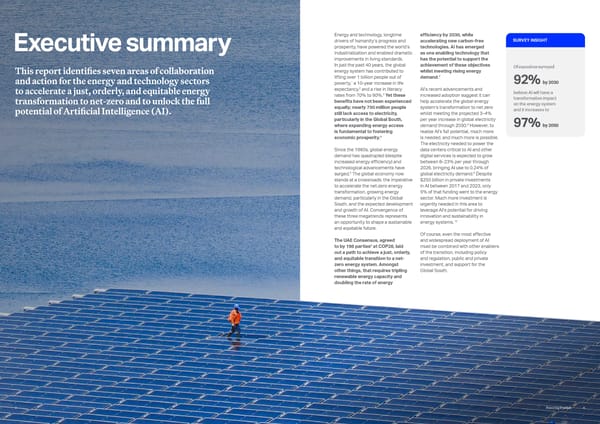Executive summary Energy and technology, longtime drivers of humanity’s progress and prosperity, have powered the world’s industrialization and enabled dramatic improvements in living standards. In just the past 40 years, the global energy system has contributed to lifting over 1 billion people out of poverty,1 a 10-year increase in life expectancy,2 and a rise in literacy rates from 70% to 90%.3 Yet these benefits have not been experienced equally; nearly 750 million people still lack access to electricity, particularly in the Global South, where expanding energy access is fundamental to fostering economic prosperity.4 Since the 1960s, global energy demand has quadrupled (despite increased energy efficiency) and technological advancements have surged.5 The global economy now stands at a crossroads: the imperative to accelerate the net-zero energy transformation, growing energy demand, particularly in the Global South, and the expected development and growth of AI. Convergence of these three megatrends represents an opportunity to shape a sustainable and equitable future. The UAE Consensus, agreed to by 198 parties6 at COP28, laid out a path to achieve a just, orderly, and equitable transition to a net- zero energy system. Amongst other things, that requires tripling renewable energy capacity and doubling the rate of energy This report identifies seven areas of collaboration and action for the energy and technology sectors to accelerate a just, orderly, and equitable energy transformation to net-zero and to unlock the full potential of Artificial Intelligence (AI). efficiency by 2030, while accelerating new carbon-free technologies. AI has emerged as one enabling technology that has the potential to support the achievement of these objectives whilst meeting rising energy demand.7 AI’s recent advancements and increased adoption suggest it can help accelerate the global energy system’s transformation to net zero whilst meeting the projected 3 –4% per year increase in global electricity demand through 2030.8 However, to realize AI’s full potential, much more is needed, and much more is possible. The electricity needed to power the data centers critical to AI and other digital services is expected to grow between 8 –23% per year through 2026, bringing AI use to 0.24% of global electricity demand.9 Despite $250 billion in private investments in AI between 2017 and 2023, only 5% of that funding went to the energy sector. Much more investment is urgently needed in this area to leverage AI’s potential for driving innovation and sustainability in energy systems.10 Of course, even the most effective and widespread deployment of AI must be combined with other enablers of the transition, including policy and regulation, public and private investment, and support for the Global South. SURVEY INSIGHT believe AI will have a transformative impact on the energy system and it increases to Of executives surveyed 92% by 2030 97% by 2050 6 Powering Possible 5
 Powering Possible 2024: AI and Energy for a Sustainable Future Page 3 Page 5
Powering Possible 2024: AI and Energy for a Sustainable Future Page 3 Page 5